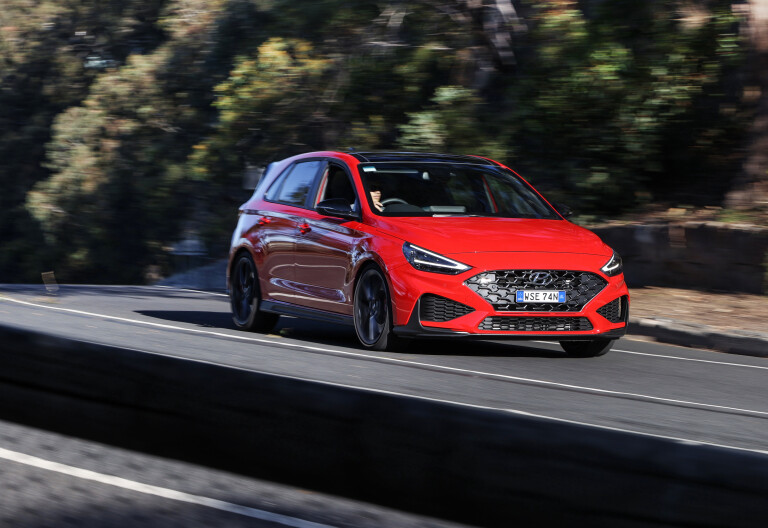
- Update 1: In our clutches
- Update 2: Strip, with no tease
- Update 3: Munching twisties
- Update 4: Cruising altitude
- Update 5: Urban grind
Update One: In our clutches
| Price as tested | $52,000 |
|---|---|
| This month | 406km @ 9.2L/100km |
| Overall | 406km @ 9.2L/100km |
The four years spent waiting for the Hyundai i30 N DCT have felt like an eternity. Back in 2017, after Hyundai coaxed former BMW M boss Albert Biermann away from retirement to build its first hot hatch, and to raging success, everyone knew the i30 N would never realise its sales potential until it delivered one thing: an automatic option.
Yet, Hyundai was already developing an eight-speed dual-clutch. At that stage the prototype ’box could already handle lofty torque limits, something which denied the i30 SR’S dry-clutch seven speed DCT from ever partnering with the i30 N’s grunty 2.0-litre four-banger. Anticipation grew for the transmission as Hyundai announced a provisional late-2019 launch.
But Hyundai was, in fact, taking its time. It was anxious to hit crucial refinement and economy targets. On one hand, this was reassuring. Hyundai was exercising caution to ensure we got a reliable, well-calibrated transmission. However, rivals like Ford and Renault Sport were already racing to introduce their own auto hot-hatch heroes.
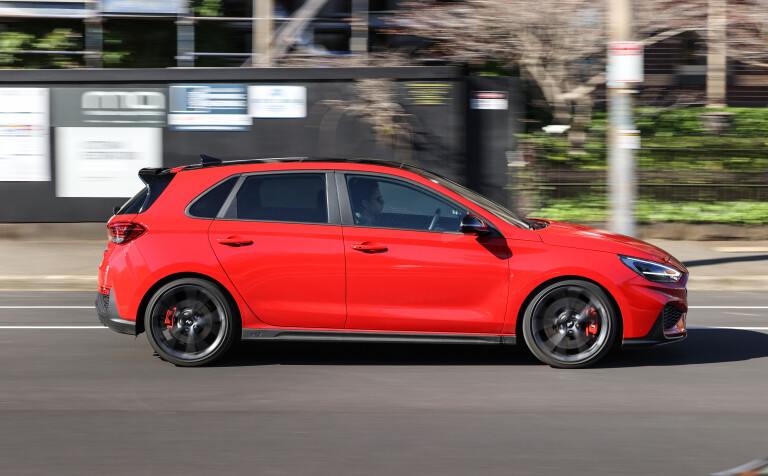
After reading the new i30 N DCT’s on-paper numbers, though, I get the feeling it has been worth the wait. Not only is the 2021 Hyundai i30 N a fitter, meaner and leaner machine, it seems there’s no apparent compromise in opting for the dual-clutch transmission besides paying another $3000.
This comes on top of a $4510 generational price hike for the new i30 N, opening at $44,500 for the manual. The higher price brings a small bump in peak power and a decent helping of extra torque, up 2kW and 39Nm, taking outputs from 202kW/353Nm to 206kW/392Nm in either the manual or dual-clutch version.
Despite the new transmission adding its own oil-filled cooling circuit to the nose of the i30 N to keep its clutches cool, which contributes to a 33kg increase over the manual, the DCT variant is claimed to reach 100km/h in 5.4sec. That’s 0.5sec quicker than the new manual i30 N, already 0.2sec up on the old car’s 6.1sec claim.
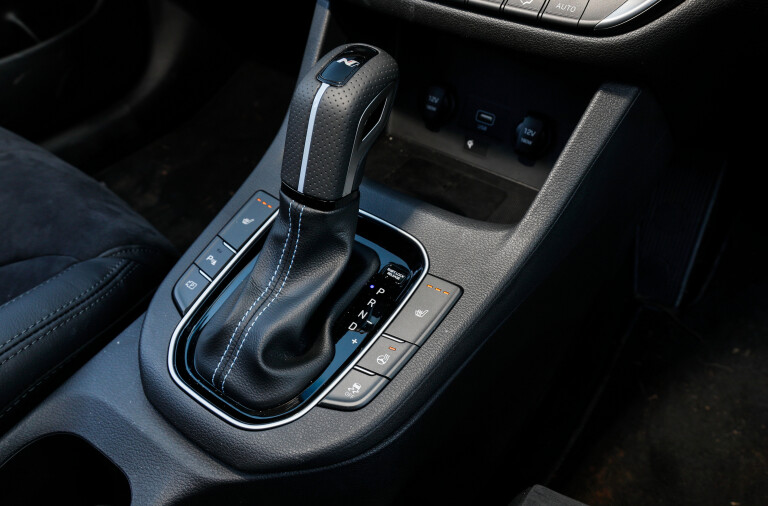
Functions specific to the DCT, like an adjustable launch control, play a part in this. And we look forward to testing the accuracy of our DCT’s acceleration claim.
Other new goodies include redesigned 19-inch wheels that shave 3.6kg from each corner, coming wrapped in bespoke Pirelli P-Zero tyres. The car’s spring rates and damping, as well as alignment settings, are newly tweaked to suit redesigned suspension hardware. The front brake discs have grown, too, from 345mm to 360mm.
Built in Czechia, you’ll also notice the N is the only locally supplied i30 hatch to score the European model’s complete facelifted front-end. This is marked by LED headlights equipped with V-shaped daytime running lights.
But the N badge ups the visual aggro with unique grille inserts, aero-guides in the front bumper, a rear spoiler with an oh-so-cool rally-style central brake light, a specific rear bumper and new dual bazooka-sized exhaust tips.
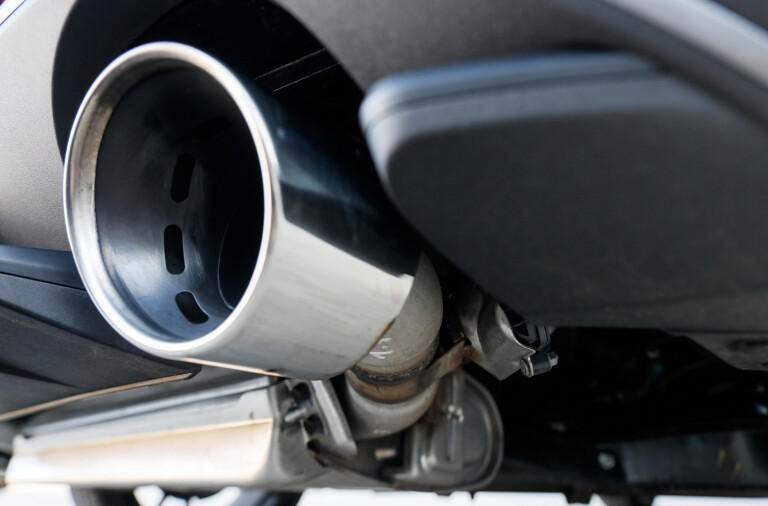
My i30 N DCT, bearing the rego WSE 74N, also comes in Engine Red, which deletes the model’s iconic red GTI-aping pin stripes from the front and rear bumpers. I feel guilty admitting I would have preferred it in Phantom Black, but beggars can’t be choosers.
Consolation comes from my example’s top-of-the-range specification. The DCT version of the i30 N can only be had with either base or N Premium Sunroof trim. And as you can see, mine has a panoramic power sunroof.
This $4500 upgrade on top of the base N DCT, taking its total price before on-roads to $52,000, is the only way you’ll get to upgrade key specification when putting an i30 N in your driveway. The sole option for this model range, otherwise, is $500 for metallic black paint.

On top of the base car, the grade adds heated front seats and steering wheel, auto windscreen wipers and lightweight adjustable front bucket seats. The latter items are especially trick. They’re finished in Alcantara, shed 2.2kg in total and contain ‘N’ logos that illuminate in the dark.
Besides a new gear lever, and an updated cabin inherited from the i30, most of the car will feel familiar to pre-facelift i30 N owners. For instance, it has the same quick-access N mode button on the wheel which wakes up adjustable hardware – like the eLSD, adaptive dampers, adjustable exhaust, ESC, steering and transmission – in a blink.
Over the next six months, I’ll explore the N Performance menu through the updated centre screen in a range of scenarios, including the track, strip and road. But most importantly, I’ll strive to answer if this i30 N DCT can justify a whopping $52,000 price tag this far into its life. Because we’ve all waited long enough.
Update 2: Strip, with no tease
| This month | 746km @ 9.6L/100km |
|---|---|
| Overall | 1154km @ 9.4L/100km |
As far as understatements go, calling the new i30 N a facelift, especially in automatic guise, is like saying Amazon is just an online store. Yes, the i30 N wears a more expressive face with sharpened features, but leaving it at that ignores so much else.
As mentioned last month, Hyundai claims that the i30 N DCT, when unleashed from a standstill, can launch itself to 100km/h from rest in 5.4sec. That’s 0.7sec quicker than the pre-facelift version with a manual transmission, or 0.5sec better than the new manual.
Among the i30 N’s rival set, not the Ford Focus ST, Renault Megane RS, or even the eighth-gen Volkswagen Golf GTI (which won’t have a manual in Australia) can match that leap in performance with a simple box-tick. None even come close to the outright 0-100km/h claim at all.
So, naturally, when the video department asked if they could film the i30 N DCT for a YouTube video at Heathcote Park Raceway, I jumped on a small window available for me to test the car.

The dragstrip would answer something nagging me since reading the spec sheet: does 4kW and 39Nm equal that much improvement? Remember that torque improvement also shrinks to 14Nm when you take into account that the pre-facelift i30 N activated a clandestine overboost system. In the right temperatures, it helped the i30 N produce 378Nm.
While the i30 N’s updated four-cylinder turbo engine, codenamed G4KH, misses out on an overboost function, it does get serious new hardware. Hyundai has completely redesigned the turbocharger system, increasing the compressor wheel size 3mm, the turbine wheel 5mm and the turbine’s scroll area by 25 percent.
Reversing the turbocharger’s shaft rotation from clockwise also allows better exhaust flow, and the intercooler’s now 4 percent larger. Engineers shored up the engine block, too, while introducing new pistons and exhaust valves.
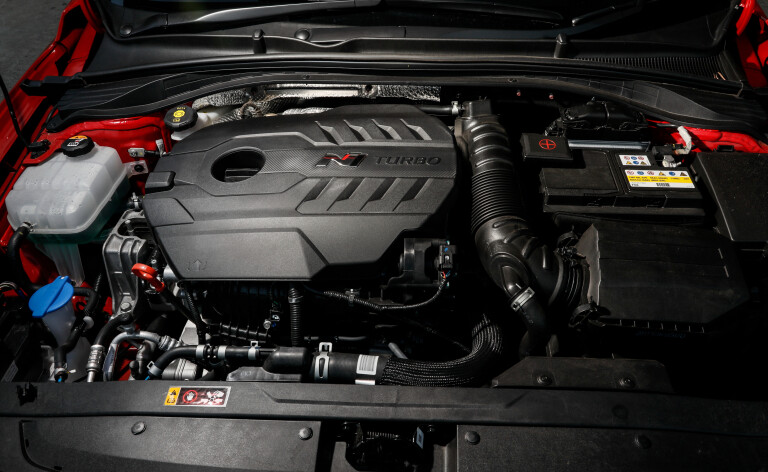
Drastic changes like these reap more than an increase in peak numbers. The new engine makes more power than before, and for longer, with the surplus difference in kilowatts growing exponentially between 2000rpm and 5500rpm.
Thankfully, it seems the weather gods want an answer on the new i30 N’s acceleration as well. Conditions at the strip are dry, wind is low, and the temperature sits in the teens. Fellow road tester Scott Newman has already completed some runs in the i30 N DCT, one of them without launch control.
Fumbling a getaway procedure results in 0-100km/h in 6.1sec and a 14.2sec pass over 400m – times that would match the best a pre-facelift i30 N could muster with launch control. Now, that would be promising if Hyundai didn’t say the new manual is good for 5.9sec. Time to reveal its true potential.

Setting up launch control is easy. Select the Sport Plus or N drive mode and ESC Sport at a minimum through the central screen. Or you can thumb the oversized N button on the steering wheel, which feels like you’re about to launch a missile.
Next, press N-mode on the 10.25-inch centre screen, then Performance Options. Launch Control is on the first tab, allowing you to choose an engine speed between 2500-3500rpm for, well, launching, which can be otherwise adjusted through the steering wheel’s speed increment buttons after you pin the throttle.
Two-step the pedals, lift the brake, and the new DCT manages torque delivery and clutch engagement perfectly without any axle tramp or excess wheelspin. It launches cleaner than any powerful front-drive manual hot hatch could ever dream. First gear can stretch to 58km/h, but the DCT upshifts earlier than the 6750rpm redline as power tapers off after 6000rpm.
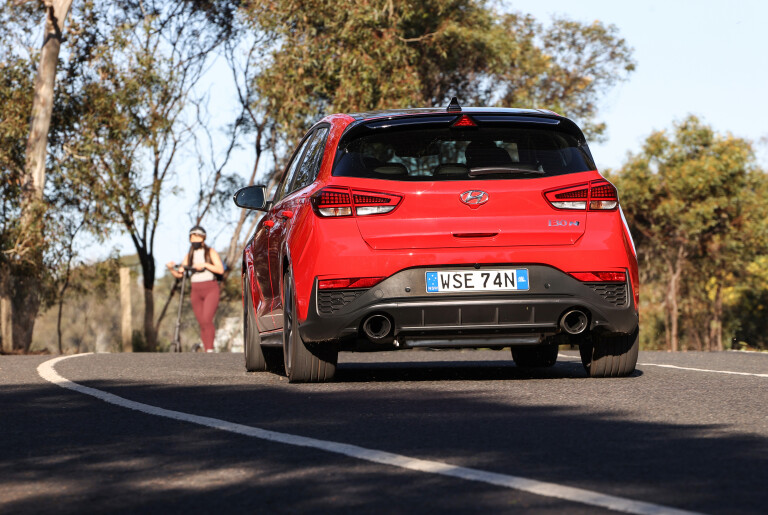
What strikes you once you’re away is how much extra grunt there is in the mid-range. The i30 N pins you to your seat, ejecting a guttural bark on each upshift with the signature ignition-cut sound of a dual-clutch. On a roll, the ’box shifts rapidly, and 80-120km/h disappears in 3.1sec – only a couple tenths off the recent Honda Civic Type R’s 2.9sec.
Importantly, within two runs, the i30 N DCT nails its 5.4sec 0-100km/h claim. There’s more in it, though. Switching off ESC and trying to steer as straight as possible shaves off another tenth, dropping the 0-100km/h time to 5.3sec. And back in the pits, someone says the DCT can even do an incredible 5.2sec. But not today.
Ultimately, the i30 N DCT’s 13.55sec 0-400m time at 171.8km/h is a tenth quicker than what sister magazine MOTOR recorded with a Type R, the fastest FWD they’ve tested in recent memory and the segment benchmark. And to do that, repeatedly without a hiccup, underscores that this new i30 N is much more than a facelift.
Next month, we’ll investigate what that means on roads more winding.
Update 3: Munching twisties
| This month | 365km @ 11.95L/100km |
|---|---|
| Overall | 1519km @ 10.0L/100km |
I’ve never enjoyed geometry as much as I am right now, parked in the i30 N DCT at the bottom of Victoria’s Mount Donna Buang.
I’m currently preparing my attack on its sinuous mountain road, playing race engineer on the ‘N Mode’ page within the centre screen’s infotainment display.
Here I can adjust the i30 N’s individual driving parameters for the Custom drive mode, accessed with a double-tap on the N button underneath the right wheel spoke. Just like in the pre-facelift i30 N.
But the ‘N mode’ page has been redesigned. Instead of tapping into a separate page for each piece of hardware, their adjustable settings are all laid out at the points of a spider’s-web chart.

You can set up the adaptive suspension, steering weight, ESC, engine and DCT by the way of three modes. The e-LSD, meanwhile, is bi-modal. Their first settings are the most sedate, and sit on an inner ring within said web, while the max settings sit on the perimeter.
Having all settings on the one page, ready at one touch, drastically improves on-the-fly accessibility.
For a racetrack, you’d spread the chart as wide as possible, all the way to each corner. But going up Mount Donna Buang on a road defined by undulations, bumps and a wide range of corners requires more finessing of my web’s shape. And I’m intrigued about how the i30 N’s suspension now handles.
For example, the front suspension uses new knuckles and lower control arms to increase the front negative camber to 1.7 degrees and front track by 17mm. As well as that, the spring rates are stiffer by 5.7 percent in the front and 4.2 percent in the rear. Local engineers have also re-valved the dampers for increased ride comfort, while the rear toe arms and bushings are new, claimed to aid mid-corner response.
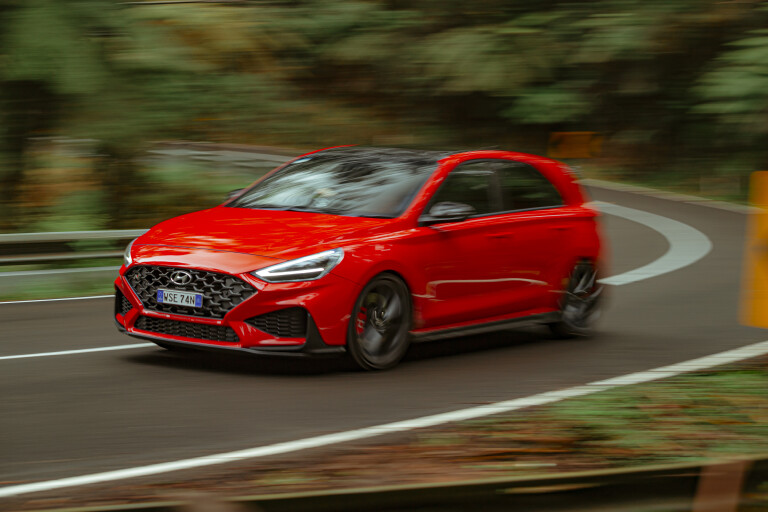
My baseline Custom mode set-up is mixed. I begin the adaptive damping in its softest setting, the steering in its heaviest, the e-LSD in the lower locking threshold and the ESC in its middle mode, Sport. As for the powertrain, I crank everything to full.
Mount Donna Buang’s ascent is punctuated by two toilet stops, creating three sections of road. Setting off, the i30 N’s low-slung chassis resists body roll like it’s on rails through the first section’s smooth, constant radius bends – even on the softest damping.
Roadholding is only questioned by two pronounced mid-corner bumps that allow the i30 N to linger a touch too long on rebound for my liking. But there’s enough suspension travel to keep each wheel on the ground.
In response, I jack up the damping to its mid-level, after the stiffest setting rattled the i30 N like it suddenly found a cobblestone road. Medium damping strikes a sweet balance between body control and an ability to iron out bumps with impressive pliancy.
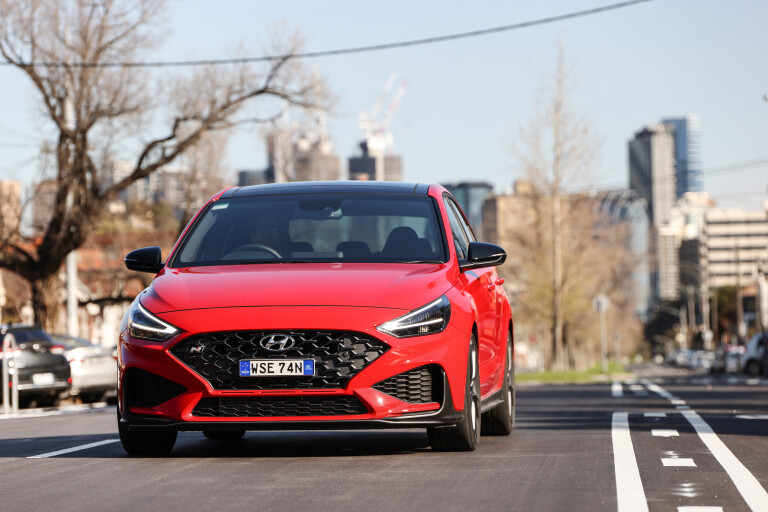
But as you push harder, traces of torque steer emerge when powering out of low-speed bends. It’s particularly bad in the Mountain’s second section snaking through a left-right switchback that crests an undulation, and shifting early to a higher gear helps dilute the amount of torque fed to the front hoops.
Meanwhile, ramping up the e-LSD to its higher setting boosts traction to impressive levels for a 392Nm front-drive hatch, but sometimes you can feel the 235mm-wide Pirellis only just holding your intended line.
Continuing up the ’Buang, the steering is direct and responsive. But while the heaviest setting helps steady the tiller during torque steer or kickback from road imperfections, it also slightly insulates feedback. Medium is the best compromise. It’s still firmly weighted, but allows you to read grip levels with a good amount of fidelity.
What’s clear is that none of these adjustable toys, including the ESC, ever waver the i30 N’s trademark sure-footedness. The grip balance remains evenly distributed and the i30 N only hoists an inside rear wheel with late trail braking.

The N’s front end is also resolute and has banished the pre-facelift model’s chattery on-limit understeer. But these Pirelli P-Zeros do still limit your level of commitment.
As for the powertrain, I’m surprised to find the eight-speed DCT upshifting between corners when you’re holding a steady throttle. A Track Sense Shift program (activated in the ‘N mode’ page) counters this by choosing sportier ratios by sensing when you’re having a go. However, the DCT’s so obedient and quick, I prefer manual mode.
Away from civilisation, as well, the exhaust’s maniacal pops and bangs are to be revelled in with open windows. After a couple runs up and down the Buang’s first two sections, I’m convinced the i30 N’s changes work cohesively. They unlock higher realms of performance and enjoyment without losing any of its well-known accessibility. Custom mode never loses its fun, either.
The i30 N is not a fundamentally changed handling machine, but it’s certainly improved, leaving the hot-hatch’s reputation in excellent shape.
Update 4: Cruising altitude
| This month | 1038km @ 10.8L/100km |
|---|---|
| Overall 6125km | 6125km @ 10.3L/100km |
Touring ability is essential for the modern sports car. With the best roads, racetracks and hillclimbs often in the middle of nowhere, long hours behind the wheel are usually necessary. And whether they leave you relatively fresh at the end – or with ringing ears and homicidal urges – depends entirely on your vehicle of choice.
Today, that’s our Hyundai i30 N DCT long-termer which we are going to fire up the Hume Highway from Melbourne to roughly Wangaratta and back, a 1038km experiment to find if the experience is more Qantas First Class or Backwater Airlines Economy.
Our first moments behind the wheel of the i30 N are, with the prospect of many hours at the wheel ahead, cause for mild concern. Deep and snug bucket seats might hold you superbly in the twisties, but firm padding threatens over the hours to anaesthetise muscles you didn’t know you had.
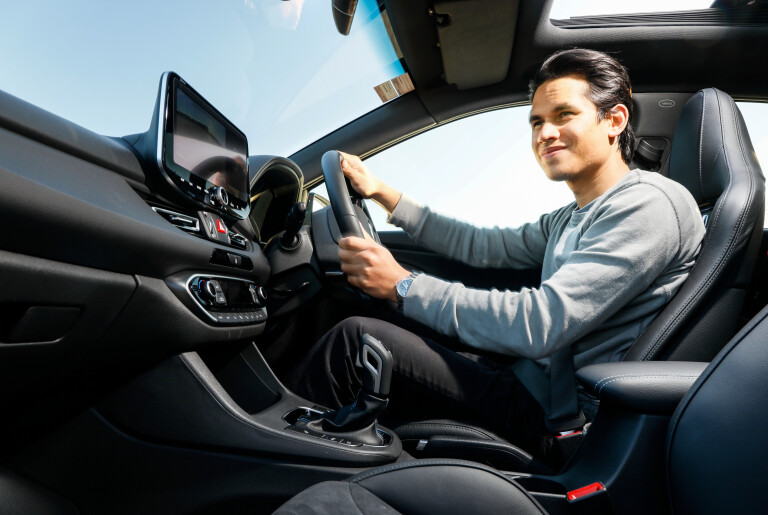
The first hundred metres in the i30 N, too, reveal a seriousness within the chassis that, while kinda cool, is omnipresent – a harshness from stiffly side-walled tyres and from suspension bushes felt to be made from the stiffest polyurethane available. A body that seems torsionally stiff like it’s got a full touring car roll-cage also tends to have a bit of an amplifying effect.
Luckily, though, despite the slightly elevated levels of vibration and harshness, there is a softness to the suspension itself providing an unexpectedly lovely ride quality that redeems massively – and somewhat saves the day.
The new twin-clutch automatic, too, is excellent around town, as smooth and clever as you’d want it to be. There is an eagerness to get away from a standstill that takes a bit of getting used to; take a bit of pressure off the brake pedal and the clutches start engaging straight away, the car aggressively creeping whether you wanted it to or not, but otherwise we couldn’t fault it.
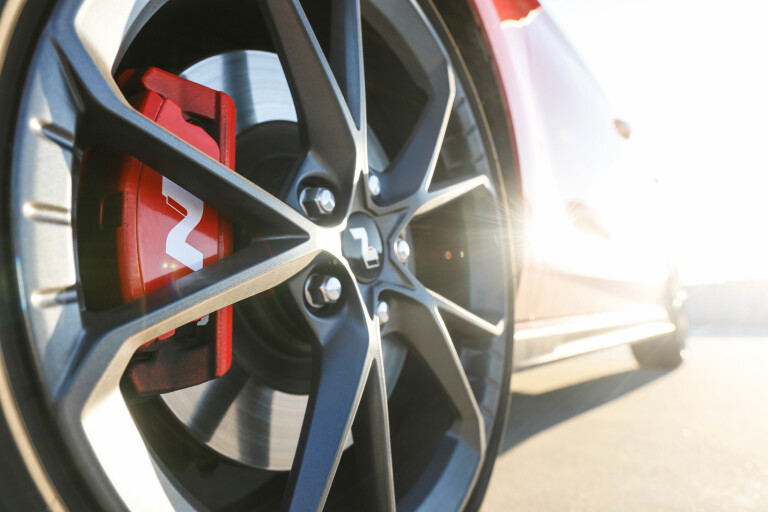
Out on the open road, despite stretches of coarser bitumen booming into the interior like the speakers are blasting static at a rude volume, the i30 N acquits itself satisfactorily as a freeway tourer. It’s the little things that make life easier, like the speed displayed nice and clear in the centre of the instruments; same for the distance-to-empty.
There’s also blind-spot monitoring so you don’t crash into that dill in the grey car that’s matched your speed off your five o’clock; cruise control that’s easy to use (if not of the radar type) and lane-keeping assist that, delightfully, is easy to switch off via a steering wheel button. A nice little feature is the ability to set the one-touch indicators to blink three, five or even seven times if you want. (On the Hume, I’m a five-blink kinda guy – Victorian drivers need plenty of notice.)
Apple CarPlay (or Android Auto) also makes it easy to navigate podcasts, music and Google Maps via the centre 10.25-inch touchscreen. Meanwhile the six-speaker stereo was more than happy to turn ‘All That She Wants’ by Ace of Base into unsociable quantities of decibels (it’s stuck in your head now, isn’t it?). These help make up for an interior that’s a bit $17,990 driveaway – although to be fair, the bits that you do touch the most like the seats and steering wheel are a contrast in how nice they are.
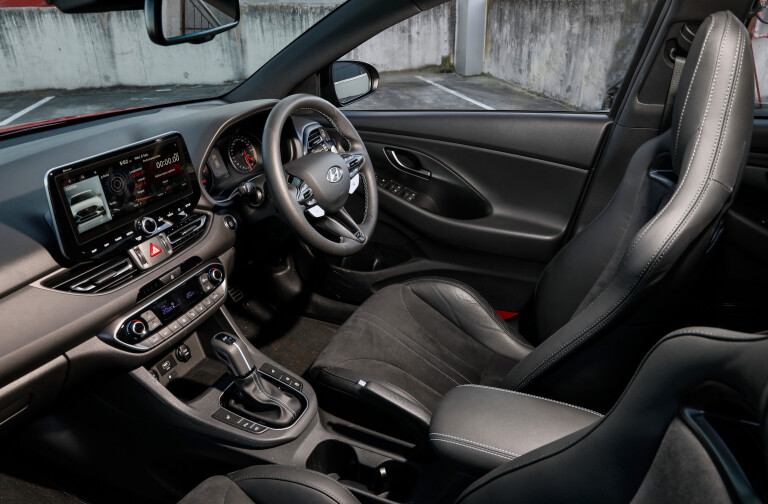
As you’d expect from something with 206kW and 392Nm, overtaking is pretty easy… although the turbo needs a bit of notice if you’re low in the revs and when the power does arrive – quite suddenly – the thing wants to jettison itself into oncoming traffic. It’s a turbo lag and torque steer party like it’s 1999.
Fuel economy is more than good enough to rival airfare prices Sydney to Melbourne. A full 50-litre tank should, in theory, give about 750km range at the claimed 6.5L/100km extra-urban consumption, and the i30 N will take 95RON. The best as-tested, general consumption we’ve got so far is 8.3L/100km but with some actual effort would drop considerably further.
Without a doubt, the i30 N has compromised a lot of comfort for performance – but not by that much compared to say, a regular i30 (if the springs were stiffer, it might be a different story). And it’s performance you’re more than happy to ‘pay’ for, especially when you arrive at your far-flung road or racetrack and hit that ‘N’ button on the steering wheel. This is a proper driver’s hot hatch as we’ll explore in coming issues. So for now call it Qantas Premium Economy, or Backwater Airlines First Class – with a few chickens in the overhead lockers.
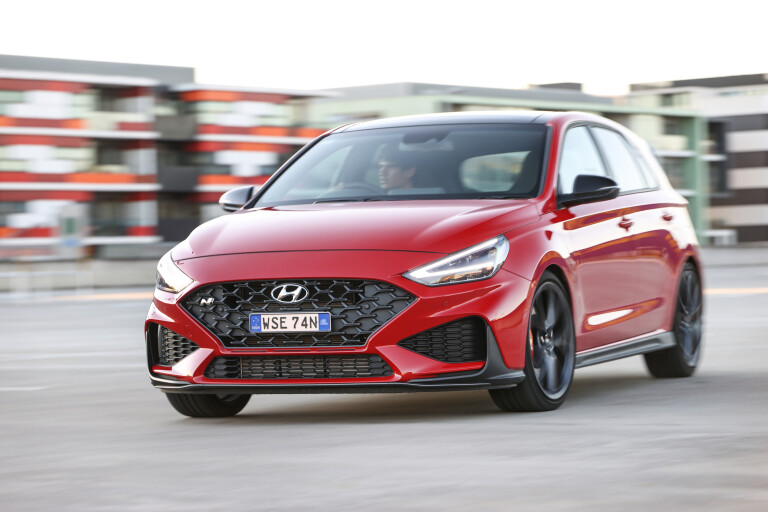
Update 5: Urban grind
| This month | 1292km @ 9.05L/100km |
| Overall | 4274km @ 10.55L/100km |
Have you ever been embarrassed by your car? I have. When I started up the Hyundai i30 N in my neighbourhood street one early morning, I winced as the i30 N’s exhaust tips shattered the pre-dawn peace with the car’s soundtrack. There isn’t much you can do to suppress the i30 N’s exhaust note during a cold start, either. The idle plays a bassy tone, no matter what the revs are, sometimes fooling me to think the exhaust’s valves are stuck open until I accidentally hit the N-mode button. Then it really turns things up.
I love the i30 N’s wild streak far away in the mountains, but its obnoxious exhaust has even strained relations closer to home. Hovering my thumb over the N mode button with my girlfriend on board, which instantly flicks the exhaust valves open, always draws a cold stare.
It serves as a reminder that daily manners are important in a hot hatch. For instance, when reminiscing about the late Honda Civic Type R, it’s not just the Type R’s mind-blowing performance that sticks in mind, but also how liveable it was day-to-day.

Keeping that in mind, we reckon the i30 N’s doing all right as a daily chariot. Thankfully, the i30 N’s soundtrack is more subdued while moving in its Normal or Eco modes. The engine also partners nicely with the dual-clutch transmission, which acquits itself incredibly well around town for driveability.
The DCT behaves much like a torque converter in start-stop traffic, taking off smoothly from a standstill. Transmission creep is strong, but you can switch it off if you find it unnerving. Otherwise, the surge forward is easily managed with
light braking.
You’re only confronted with the car’s seriousness when the DCT clunks downshifting to first gear sometimes when you come to a stop. It’s perfectly normal and imbues the transmission with a race-bred feel. But when cruising in any mode other than Sport+, the DCT’s operation is refined to the point of anonymity.
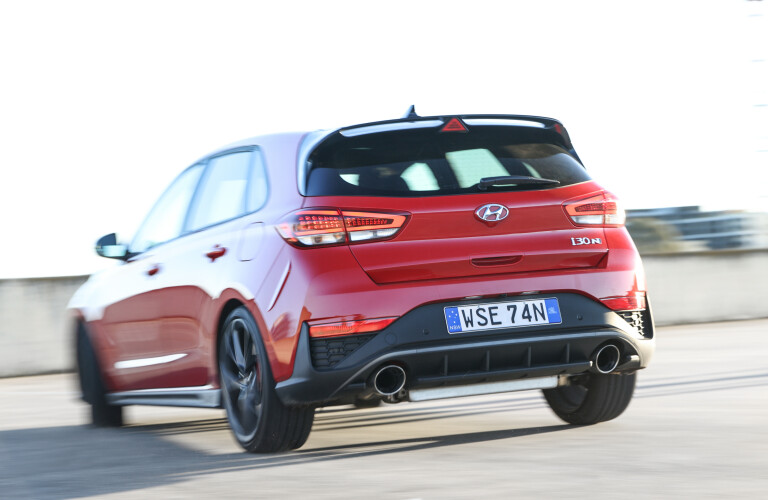
As for the engine, its larger turbocharger has lifted the i30 N’s peak outputs higher in the rev range. It now delivers a stronger top-end rush, but driving around town on part throttle reveals the car’s significant mid-range torque is slightly delayed compared to the old i30 N. This is easy to overcome when keeping with traffic, you simply add more throttle before the boost arrives. But the lag is noticeable when trying to seize a gap or jump across lanes.
Beyond this power delivery niggle, the i30 N can be tricky to manoeuvre in tight situations. The steering is heavy off-centre. And although engineers quickened the steering to 2.14 turns lock-to-lock (from 2.57), the turning circle has grown from 10.6m to 11.6m.
Because of this, whipping the i30 N around in anything less than a wide street requires a three-point turn. Thankfully, the DCT tackles the change between forward and reverse gears without fuss, smoothly taking up either drive even before you’ve fully come to a stop.
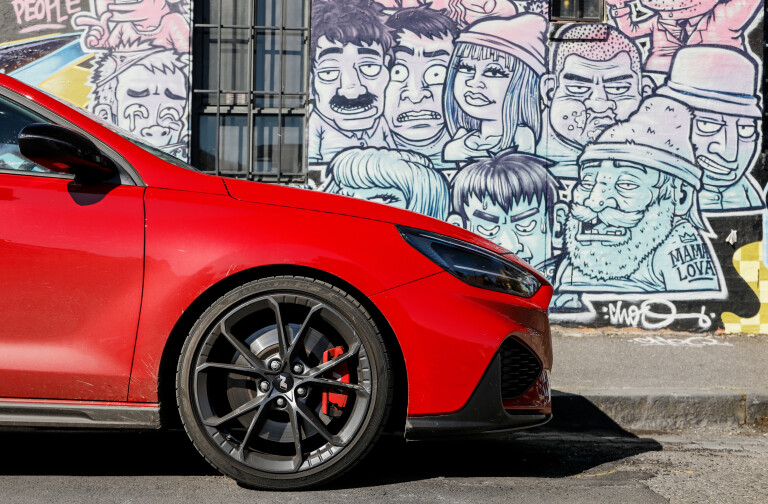
Despite Hyundai cranking up the spring rates on the i30 N for this facelift, the dampers also provide a cushioned ride when they’re slackened off in Normal or Eco modes and offer excellent wheel control over small imperfections.
You’ll have to amble over speed humps, though, since soft damping under compression lets the front-lip scrape the road if you’re not careful. Or at least that’s what it feels like.
I once jumped out of the driver’s seat expecting serious damage, only to discover a dam integrated into the underside of the bumper. This protective piece extends 25mm underneath the front lip and sounds a crucial warning when it graunches into the pavement.
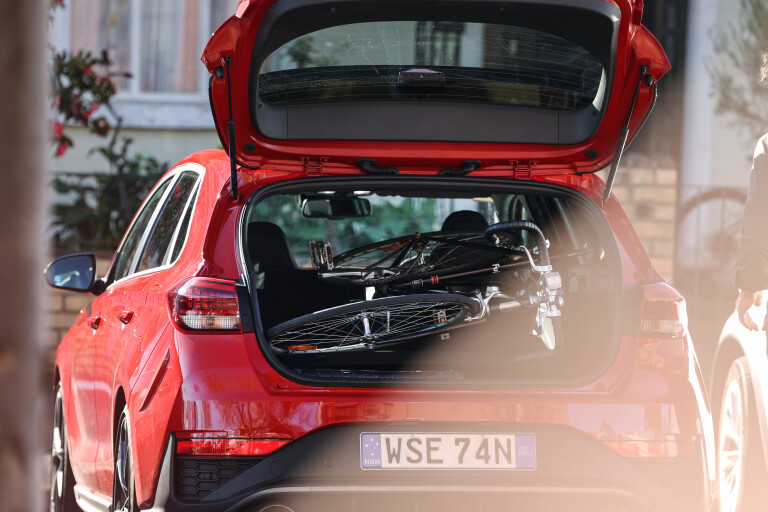
As you’d expect from a city car, parking the i30 N is simple enough once you’ve adapted to the larger turning circle and heavy steering. I’d only recommend parallel parking in quiet streets, as the sensitive Rear Cross Traffic alert will jam the brakes on unnecessarily when it detects traffic passing a lane over.
As for small things, the central cupholders won’t accommodate a protein shaker, but they at least fit coffee cups and small drinks. But otherwise, storage is great. The boot easily swallows my bicycle when the rear seats are dropped flat. And when the seats are up, the 381L rear boot accommodates a large amount of stuff in its sunken floor.
As time goes on, the i30 N DCT has proved incredibly versatile, even if slightly flawed. It's an easy one to recommend.

COMMENTS